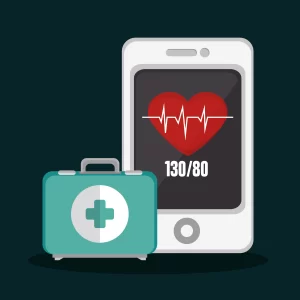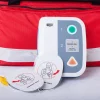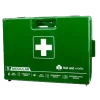
Recent Post
 Could You Recognise the Signs That Someone Needs a Defibrillator?
Could You Recognise the Signs That Someone Needs a Defibrillator?
September 12, 2023
Introduction
Emergency medical situations often call for quick. Decisive action, with lives hanging in the balance. Among the critical life-saving equipment at our disposal, defibrillators are of utmost importance. These devices deliver a dose of electric current to the heart. Essentially jumpstarting it back to a normal rhythm. In instances of life-threatening cardiac arrhythmias.
The efficacy of a defibrillator is direct. Dependent on the quality and reliability of its battery. The silent and often overlooked hero. Choosing the right defibrillator battery is. Therefore, not only crucial for the device’s optimal functionality. But also the assurance of a life preserved in an emergency. In this comprehensive guide, we will delve into the key considerations. To bear in mind when selecting a defibrillator battery.
Understanding Defibrillator Batteries
A defibrillator battery serves as the power source that enables the defibrillator. To deliver the potentially life-saving electrical shock to a heart experiencing irregular rhythm. The battery powers the defibrillator’s capacitor. Which charges and discharges the electric current through the defibrillator’s pads.
The lifespan and performance of a defibrillator are largely. Determined by the quality and condition of its battery. A weak or failing battery could render a defibrillator ineffective. potentially leading to tragic outcomes. It is thus essential to fully understand and carefully. Choose the right defibrillator battery.
Types of Defibrillator Batteries
Defibrillator batteries can broadly be categorised into two types: rechargeable and non-rechargeable.
- Rechargeable Batteries: These batteries are designed to be used repeatedly . By recharging once they’ve depleted their stored energy. They are generally used in hospital settings where defibrillators are frequently used.
- Non-rechargeable Batteries: These batteries are intended for one-time use. And must be replaced after they’ve run out of charge. They are commonly used in Automated External Defibrillators (AEDs) placed in public spaces. And are designed to hold a charge over a long period.
Each battery type has its pros and cons. The choice depends on factors like frequency of use. Device compatibility and long-term costs.
Essential Factors to Consider When Choosing a Defibrillator Battery
There are several key factors that you should take into account. When selecting a defibrillator battery.
Battery Life: One of the most crucial aspects to consider is the battery life. The battery should be able to hold a charge long enough to ensure the defibrillator is always ready for use.
Compatibility: Not all batteries are compatible with all defibrillators. It’s crucial to ensure the battery matches the specific defibrillator model. For instance, Priority First Aid offers particular models that require specific battery types.
Rechargeability: Depending on how often the defibrillator is used. A rechargeable battery may be a practical choice. However, for AEDs in public spaces that aren’t used regularly. Non-rechargeable batteries are usually more suitable.
Manufacturer Specifications: Always adhere to manufacturer recommendations when selecting a battery. Doing so ensures that the defibrillator functions as intended.
Cost: Consider the initial cost of the battery and the ongoing costs. Associated with its maintenance or replacement.
Environmental Impact: The environmental footprint of different battery types. This is also a crucial factor to consider. Rechargeable batteries often have a lower environmental impact. Than their non-rechargeable counterparts, as they result in less waste.
The Role of Technological Advances in Defibrillator Batteries
Technological advancements have significantly influenced the efficiency and longevity of defibrillator batteries. These developments not only lead to batteries. That last longer but also facilitate quicker charging times and improved overall performance. This progression is invaluable as it allows defibrillators. To be ready for use more quickly and remain so for longer periods. As such, keeping abreast of these technological advances. Is a crucial aspect of choosing the right defibrillator battery.
Common Mistakes to Avoid When Choosing a Defibrillator Battery
Selecting the right defibrillator battery is a critical task. That can often be fraught with pitfalls. Here are some common mistakes to avoid:
- Ignoring Compatibility: Not all defibrillator batteries are universally compatible. Choosing an incompatible battery can lead to poor performance. Or even damage the defibrillator.
- Focusing Only on Price: While cost is an important consideration. It should not be the only deciding factor. Cheaper batteries may not last as long or perform as reliably. Leading to higher overall costs in the long run.
Avoiding these mistakes is key to ensuring. That your defibrillator operates effectively when needed.
Conclusion
The choice of a defibrillator battery goes beyond just powering a device. It’s a decision that directly impacts the reliability. And efficiency of a life-saving tool. By considering factors such as battery life, compatibility, rechargeability, manufacturer specifications. Cost, and environmental impact, you can make an informed decision. Keep in mind that while advancements in technology continue to improve battery performance. Avoiding common selection mistakes is equally crucial.
Choosing the right battery, such as those offered by Priority First Aid. Is a step towards reliable emergency preparedness. Ensuring that your defibrillator is always ready to deliver when life calls for it.
1. Why is the choice of a defibrillator battery important?
The choice of a defibrillator battery is important. Because the battery is the power source. That enables the defibrillator to deliver a potentially life-saving electrical shock. A weak or failing battery could render a defibrillator ineffective. Which is why it’s crucial to choose a reliable and high-quality battery.
2. What are the main types of defibrillator batteries?
There are two main types of defibrillator batteries: rechargeable and non-rechargeable. Rechargeable batteries are typically used in hospital settings. Where defibrillators are frequently used, while non-rechargeable batteries are commonly used. In Automated External Defibrillators (AEDs) located in. Public spaces, designed to hold a charge over a long period.
3. What factors should I consider when choosing a defibrillator battery?
Key factors to consider when choosing a defibrillator battery include battery life. Compatibility with the defibrillator model, whether the battery is rechargeable. Manufacturer specifications, cost, and environmental impact.
4. How have technological advances improved defibrillator batteries?
Technological advances have led to improvements. In the efficiency and longevity of defibrillator batteries. These advancements mean that batteries can last longer, and charge quicker. And improve the overall performance of the defibrillator.
5. What are some common mistakes to avoid when choosing a defibrillator battery?
Common mistakes to avoid when choosing a defibrillator battery. Including ignoring the compatibility of the battery. With the specific defibrillator model and focusing solely. The cost of the battery could lead to poor performance and higher overall costs in the long run.
6. How often should I replace my defibrillator battery?
The frequency of replacement depends. On the battery type and how often the defibrillator is used. However, it’s essential always to follow the manufacturer’s guidelines. And to regularly check the battery’s power level. To ensure that the defibrillator is ready for use when needed. If in doubt, consult a professional or a reputable defibrillator provider.






